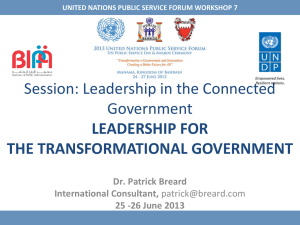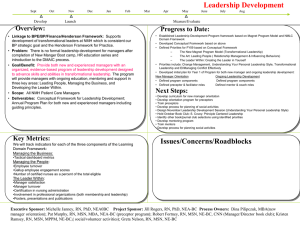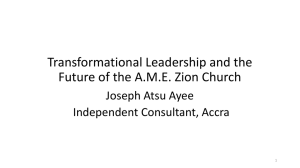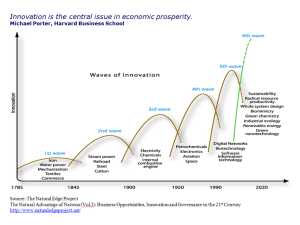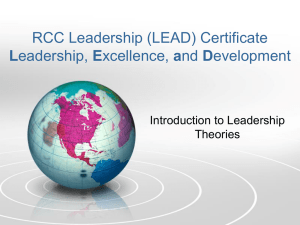The Leadership Quarterly Volume 26, Issue 6, December 2015 1
advertisement
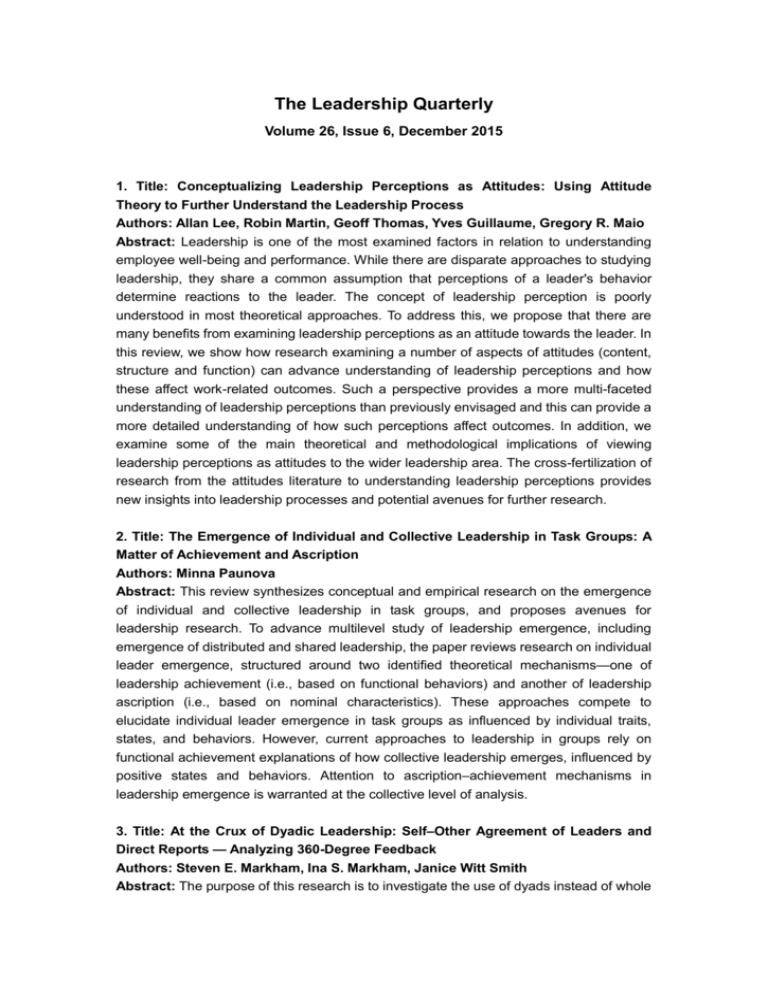
The Leadership Quarterly Volume 26, Issue 6, December 2015 1. Title: Conceptualizing Leadership Perceptions as Attitudes: Using Attitude Theory to Further Understand the Leadership Process Authors: Allan Lee, Robin Martin, Geoff Thomas, Yves Guillaume, Gregory R. Maio Abstract: Leadership is one of the most examined factors in relation to understanding employee well-being and performance. While there are disparate approaches to studying leadership, they share a common assumption that perceptions of a leader's behavior determine reactions to the leader. The concept of leadership perception is poorly understood in most theoretical approaches. To address this, we propose that there are many benefits from examining leadership perceptions as an attitude towards the leader. In this review, we show how research examining a number of aspects of attitudes (content, structure and function) can advance understanding of leadership perceptions and how these affect work-related outcomes. Such a perspective provides a more multi-faceted understanding of leadership perceptions than previously envisaged and this can provide a more detailed understanding of how such perceptions affect outcomes. In addition, we examine some of the main theoretical and methodological implications of viewing leadership perceptions as attitudes to the wider leadership area. The cross-fertilization of research from the attitudes literature to understanding leadership perceptions provides new insights into leadership processes and potential avenues for further research. 2. Title: The Emergence of Individual and Collective Leadership in Task Groups: A Matter of Achievement and Ascription Authors: Minna Paunova Abstract: This review synthesizes conceptual and empirical research on the emergence of individual and collective leadership in task groups, and proposes avenues for leadership research. To advance multilevel study of leadership emergence, including emergence of distributed and shared leadership, the paper reviews research on individual leader emergence, structured around two identified theoretical mechanisms—one of leadership achievement (i.e., based on functional behaviors) and another of leadership ascription (i.e., based on nominal characteristics). These approaches compete to elucidate individual leader emergence in task groups as influenced by individual traits, states, and behaviors. However, current approaches to leadership in groups rely on functional achievement explanations of how collective leadership emerges, influenced by positive states and behaviors. Attention to ascription–achievement mechanisms in leadership emergence is warranted at the collective level of analysis. 3. Title: At the Crux of Dyadic Leadership: Self–Other Agreement of Leaders and Direct Reports — Analyzing 360-Degree Feedback Authors: Steven E. Markham, Ina S. Markham, Janice Witt Smith Abstract: The purpose of this research is to investigate the use of dyads instead of whole rating groups for analyzing 360° feedback. A Center for Creative Leadership sample of direct subordinates was matched with their focal leaders (J = 4810 dyads). Two CCL Benchmark scales (Building & Mending Relationships and Problems with Interpersonal Relationships) were used to determine if this dyadic pairing produced high self–other agreement (SOA). Using Within and Between Analysis (WABA), results suggest the viability of detecting unitary, whole dyadic effects only under specific boundary conditions. Other conditions produced highly dispersed dyadic results. Thus, dyadic convergence is not a universal phenomenon in these data. Tying the dyadic results back to the original rater group's consistency as reported in Markham, Smith et al. (2014), those rater groups with high internal agreement form clearer dyadic pairings when compared to rater groups that were moderate or low in agreement. Implications and future directions are discussed. 4. Title: Leadership in Small-Scale Societies: Some Implications for Theory, Research, and Practice Authors: Christopher von Rueden, Mark van Vugt Abstract: Leadership studies concentrate on large-scale societies and organizations with formal hierarchies, large power differences, and diverse membership. Much less is known about leadership in small-scale, homogeneous, and relatively egalitarian societies in which humans have spent most of their existence. We summarize the anthropological literature on leadership from traditional, small-scale societies in terms of (1) the functions and roles of leaders; (2) the traits and behaviors conducive to leader emergence and effectiveness; and (3) the motivations and incentives to assume leadership positions. We address how studies of leadership in small-scale societies inform theory development. By viewing leadership and followership in light of our evolutionary history in small-scale societies, we shed new light on outstanding questions in leadership research and on challenges for leadership practice. 5. Title: Leader Reinforcement, Behavioral Integrity, and Subordinate Outcomes: A Social Exchange Approach Authors: Timothy R. Hinkin, Chester A. Schriesheim Abstract: Measures of leader reward and punishment omission and behavioral integrity have demonstrated sound psychometric properties and interesting relationships in recent studies. In this study, the psychometric properties of these new measures are first examined, supporting previous findings. Hypotheses and theoretical models incorporating these constructs, along with contingent reward and punishment, are developed and tested using a social exchange theory framework and a sample of 456 workers in 15 Northeastern U.S. restaurants. It was found that contingent reward, contingent punishment, and reward omission impact perceptions of behavioral integrity. It was also found that trust partially mediates the relationship between behavioral integrity and subordinate perceptions of organizational commitment and satisfaction (but not leader effectiveness). Limitations of the study are discussed and directions for future research are suggested. 6. Title: Perceptions of Facial Dominance, Trustworthiness and Attractiveness Predict Managerial Pay Awards in Experimental Tasks Authors: Laura S. Fruhen, Christopher D. Watkins, Benedict C. Jones Abstract: Positive associations between physical attractiveness and employee reward are well-documented within the organisational literature. Although the impact of facial cues to trustworthiness and dominance on a number of social outcomes has been established outside of the workplace, the extent to which they, in addition to attractiveness, affect pay at different managerial levels is yet to be investigated. This paper presents research into this issue using a face payment task for shop floor managers (Retail Managers) and senior managers (Heads of Retail Operations). Evaluations indicated that all three facial cues were positively associated with awarded pay at both managerial levels. Moreover, attractiveness had a significantly stronger link with shop-floor managers' than senior managers' pay, whereas perceived trustworthiness and perceived dominance had significantly stronger links with pay for senior managers than shop-floor managers. It further emerged that women were paid more in this experimental task where pay was awarded solely based on facial features and that the facial features were more predictive of women's than men's pay. Awareness of the role of physical cues in pay awards can be considered by organisations to reduce biases in remuneration. 7. Title: How Transformational Leadership Works during Team Interactions: A Behavioral Process Analysis Authors: Nale Lehmann-Willenbrock, Annika L. Meinecke, Jens Rowold, Simone Kauffeld Abstract: Transformational leadership is generally considered helpful for team functioning. However, the social dynamics underlying the benefits of transformational leadership remain elusive to date. To understand how and why transformational leadership can foster team functioning, this study focuses on leader–follower communication dynamics during team interactions. From the perspective of leadership as social problem solving, we argue that transformational leadership is linked to functional team problem-solving processes because transformational leaders use solution-focused communication (mediator model). In a sample of 30 videotaped problem-solving team meetings from two organizations, we coded transformational leadership style and the verbal behavioral interactions of leaders and team members over the course of their entire meetings (30,128 behavioral units in total). Multilevel results showed that transformational leadership was positively linked to functional problem-solving communication by team members. This positive relationship was mediated by leaders' solution-focused communication. Moreover, at the micro-level of conversational dynamics within the meeting process, lag sequential analysis revealed that leaders' ideas and solutions triggered subsequent solution statements by team members and inhibited counterproductive communication by team members, such as running off topic, criticizing, or complaining. We discuss theoretical and methodological implications for conceptualizing dynamic leader–follower processes as well as managerial implications for leading effective meetings in organizations. 8. Title: Prophets vs. Profits: How Market Competition Influences Leaders' Disciplining Behavior towards Ethical Transgressions Authors: Pieter T.M. Desmet, Niek Hoogervorst, Marius Van Dijke Abstract: We investigate how market competition influences the way leaders discipline employees' ethical transgressions. A cross-sectional study among organizational leaders (Study 1) revealed that strong market competition is related to an instrumental decision frame (business practices are more focused on serving the organization's interest). This decision frame explains why strong market competition is related to leaders' perceptions of the evaluation of wrongdoing in terms of instrumental rather than moral concerns. Two experiments (Studies 2 and 3) show that increased market competition makes leaders' disciplining of ethical transgressions more contingent upon the transgression's instrumentality to the organization: the same ethical transgression is punished less when it resulted in profit than when it resulted in loss. This research is among the first to identify conditions that determine disciplinary responses of organization leaders to ethical transgressions, and it feeds the debate on whether market competition promotes the display of unethical behavior within organizations. 9. Title: Women on Corporate Boards around the World: Triggers and Barriers Authors: Amon Chizema, Dzidziso S. Kamuriwo, Yoshikatsu Shinozawa Abstract: One of the institutions in which the gender gap remains a contestable issue is the board of directors, where the proportion of female directors is still low. While some countries have achieved higher proportions of female directors on their corporate boards, others have not registered even a single one. Drawing on social role theory, that places emphasis on traditional gender activities, this study starts by arguing that board directorship is an agentic role and more suitable for men. The study shows that key social institutions have the potential to alleviate such stereotypical attitudes or to maintain the status quo. Employing a robust statistical technique in two-stage least squares (2SLS), this study finds that the representation of women in other key national institutions, such as in politics, positively affects the appointment of female directors on boards. On the other hand, religiosity has a negative causal effect on female board appointments. 10. Title: Benefiting from CEO's Empowerment of Tmts: Does CEO–TMT Dissimilarity Matter? Authors: Yan Ling, Liqun Wei, Richard J. Klimoski, Longzeng Wu Abstract: This study examines empowering leadership from an upper echelons perspective by focusing on top management teams (TMTs) and considering the demographic dissimilarities between the CEO and other TMT members. Data from a multisource survey of 129 Chinese firms demonstrate the importance of the fit between the backgrounds of the leader and the TMT members. Although empowerment of TMTs by CEOs predicts superior organizational performance in general, the findings show that this practice is most beneficial when the CEO and the TMT members differ in their informational demographics but have a longer tenure overlap. If either dissimilarity in informational demographics or tenure overlap is lacking, the CEO's empowerment of the TMT has a less positive effect on firm performance. Essentially, a three-way interaction is demonstrated. Introducing boundary conditions for the empowerment of TMTs by CEOs and testing their interactive influence broadens our understanding of how CEO leadership style can affect organizational performance, and refines the guidance for practitioners on TMT management. 11. Title: Communication and Trust are Key: Unlocking the Relationship between Leadership and Team Performance and Creativity Authors: Kathleen Boies, John Fiset, Harjinder Gill Abstract: Considerable theoretical and empirical work has identified a relationship between transformational leadership and team performance and creativity. The mechanisms underlying this link, however, are not well understood. To identify the intervening processes inherent in this relationship, we experimentally manipulated the leadership style assigned to 44 teams taking part in a resource-maximization task. Teams were exposed either to a leader using inspirational motivation, intellectual stimulation, or a control condition. Our findings reveal important differences between leadership styles in communication and team outcomes (objective task performance and creativity). These results suggest that different dimensions of transformational leadership should be emphasized depending on the outcome sought. In addition, our results provide evidence for a sequential mediation model where leadership influences team outcomes through overall team communication and trust in teammates. This study suggests mechanisms by which transformational leaders may impact team outcomes, which has implications for team building and leadership training. 12. Title: Transformational Leadership Sub-Dimensions and Their Link to Leaders' Personality and Performance Authors: Anika Deinert, Astrid C. Homan, Diana Boer, Sven C. Voelpel, Daniela Gutermann Abstract: The multi-dimensionality of the transformational leadership construct has been under debate in the last decades. To shed more light on this issue, we conducted a meta-analysis (k = 58 studies), examining the transformational leadership sub-dimensions and their links to leader personality and performance in order to gather empirical evidence of the multi-dimensionality of transformational leadership. First, the results showed that the Big 5 personality traits are directly linked to transformational leadership sub-dimensions and to the overall measure, and are indirectly linked to leader performance. Interestingly, however, different combinations of the personality traits are differentially related to the transformational leadership behaviors. For instance, whereas inspirational motivation is related to all personality traits, only openness to experience and agreeableness affect individualized consideration. These findings emphasize the importance of examining the transformational leadership sub-dimensions separately to gain a deeper understanding of the nature and the antecedents of these leadership behaviors.




